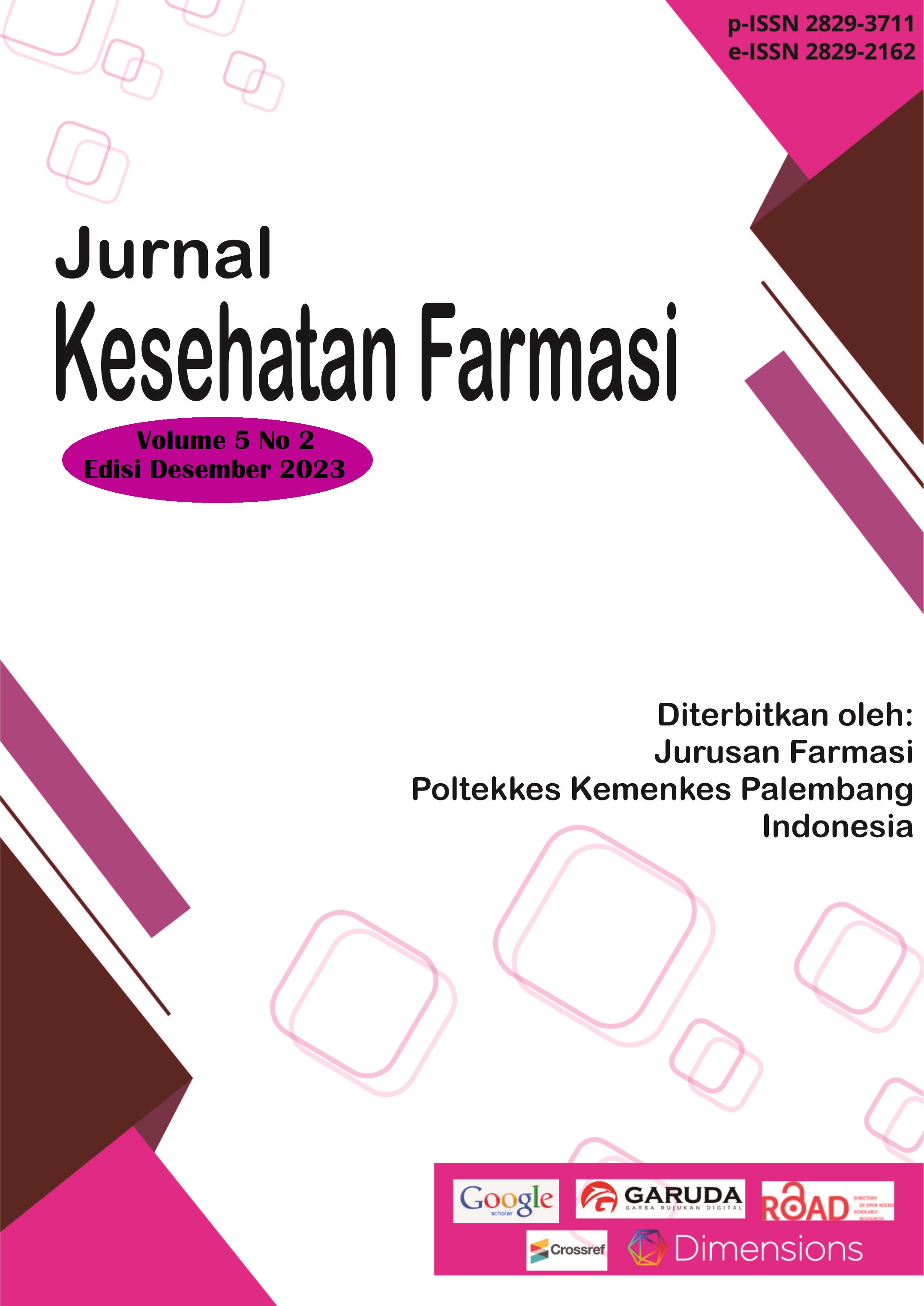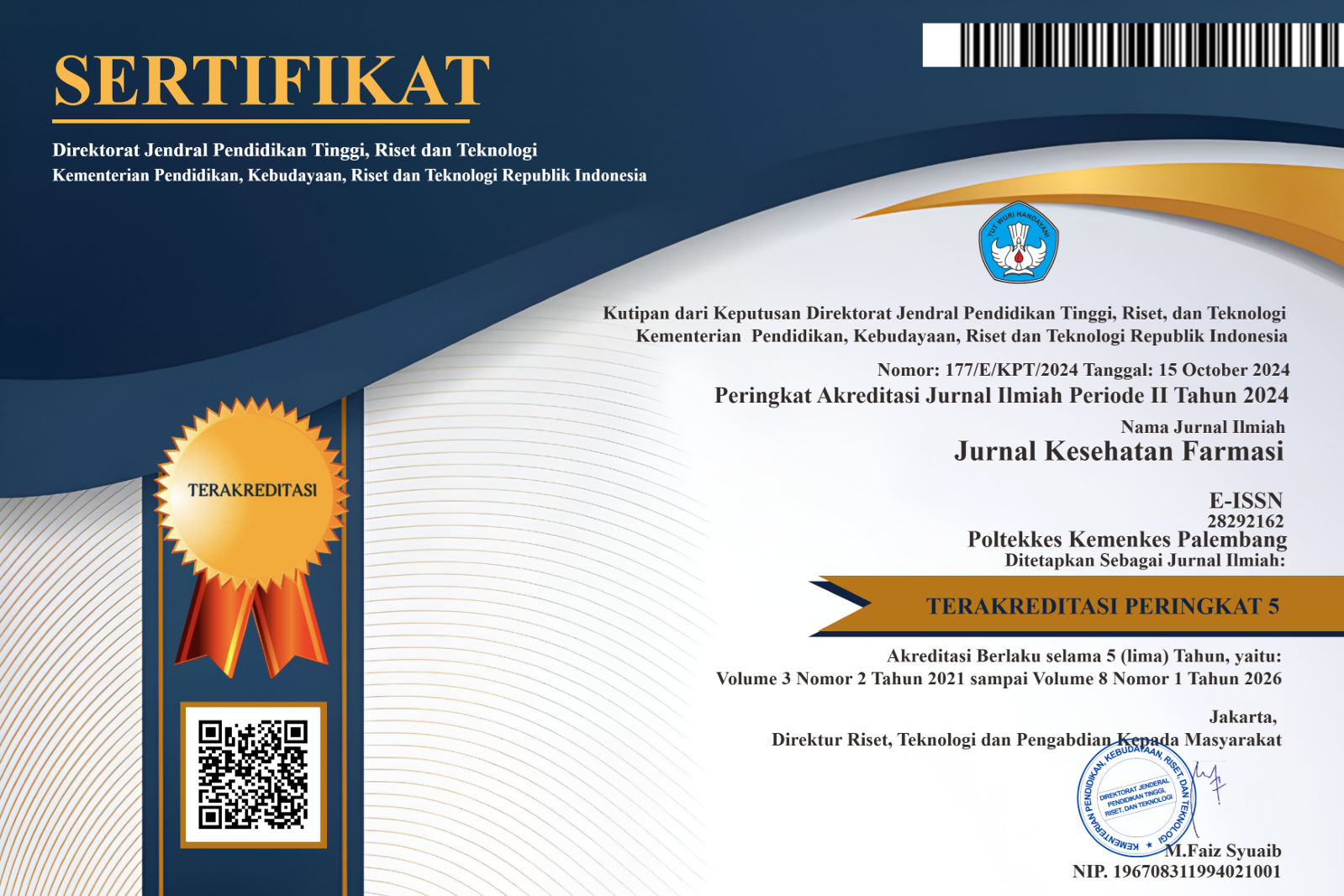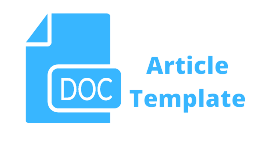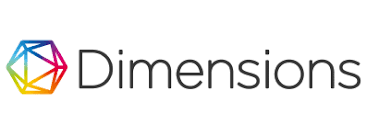Kajian Terapi Penggunaan Obat Pasien Glaukoma Terhadap Penurunan TIO Pada Rumah Sakit Di Provinsi Gorontalo
Abstract
Latar Belakang: Glaukoma adalah penyakit mata dimana terjadinya kerusakan saraf optik yang disebabkan oleh hambatan pengeluaran cairan bola mata (Humor Aquous) . Penelitian ini bertujuan untuk membandingkan monoterapi timolol dan terapi kombinasi timolol-acetazolamide pada pasien glaukoma di RSUD dr. Hasri Ainun Habibie Provinsi Gorontalo.
Metode: Penelitian ini adalah jenis penelitian deskriptif yaitu berdasarkan data-data rekam medik yang sudah ada tanpa melakukan perlakuan ataupun wawancara langsung kepada subjek uji.
Hasil: Pada pemberian monoterapi timolol diperoleh hasil pemeriksaan pertama pasien pada tahun 2020 dengan TIOD (Tekanan Intraokular Dextra ) 15,1 mmHg dan TIOS (Tekanan Intraokular Sinistra ) 16,0 mmHg, hingga pemeriksaan terakhir pasien pada tahun 2022 dengan hasil pemeriksaan TIOD 14, 1 dan TIOS 15,6, sedangkan pada pemberian terapi kombinasi timolol-acetazolamide diperoleh hasil pemeriksaan pertama pasien pada tahun 2022 dengan TIOD 31,3 mmHg dan TIOS 17,5 mmHg, hingga pemeriksaan terakhir pasien pada tahun 2022 dengan hasil pemeriksaan TIOD 24,7 dan TIOS 14,2.
Kesimpulan: terjadi penurunan Tekanan Intraokular (TIO) pada pemberian monoterapi timolol dan kombinasi terapi timolol-acetazolamide, dimana penurunan tekanan intraokular yang paling signifikan adalah pada pemberian kombinasi terapi timolol dan acetazolamide.
References
2. Cantor LB, Rapuano CJ, Cioffi GA. Basic and Clinical Science Course TM 8 External Disease and Cornea. San Francisco; 2017.
3. Budiono S. Buku Ajar Ilmu Kesehatan Mata. Surabaya: Airlangga University Press; 2013. 303 p.
4. Nurmalasari Y, Hermawan MR. Karakteristik Pasien Glaukoma Berdasarkan Faktor Instrinstik Di Rumah Sakit Pertamina Bintang Amin Bandar Lampung. J Ilmu Kedokt Dan Kesehat. 2017;4(2):85–90.
5. BPOM RI. Persyaratan Mutu Obat Tradisional, Peraturan Kepala Badan Pengawas Obat dan Makanan Republik Indonesia. Indonesia; 2014.
6. Artini W, Mustafa S, Octariana VD, Suryono A. Comparison of Ahmed Versus Baerveldt Implant Outcomes in Malayan Glaucoma Patients. Makara J Heal Res. 2018;22(3).
7. Lalita A, Yamin T, Saerang JS. Pencapaian Tekanan Intraokular Pasca Pemberian Timolol Maleat 0,5% pada Glaukoma Sudut Terbuka Primer. J e-Clinic. 2016;4(1):284–90.
8. Kim JM, Kim TW, Kim CY, Kim HK, Park KH. Comparison of the intraocular pressure-lowering effect and safety of brimonidine/timolol fixed combination and 0.5 % timolol in normal-tension glaucoma patients. Jpn J Ophthalmol. 2016 Jan;60(1):20–6.
9. Van Der Valk R, Webers CAB, Hendrikse F, De Vogel SC, Prins MH, Schouten JSAG. Predicting intraocular pressure change before initiating therapy: timolol versus latanoprost. Acta Ophthalmol. 2008 Jun;86(4):415–8.
10. August J. Perbandingan Efek Timolol dengan Kombinasi Timolol + Asetazolamid pada Terapi Inisial Glaukoma Primer Sudut Terbuka. Semarang: Universitas Diponegoro; 2008.
11. Elin Yulinah Sukandar, Andrajati R, Sigit JI, Adnyana IK, Kusnandar APS. ISO Farmakoterapi. Jakarta: ISFI; 2008.
12. Meyer D, Schalkwyk R. Update on Current Medical Therapy of Glaucoma. In: Mastering the Techniques of Glaucoma Diagnosis and Management. Jaypee Brothers Medical Publishers (P) Ltd.; 2006. p. 157–157.
13. Watson PG, Jovanovik Pandova L. Prolonged ocular hypotension: would ciliary tissue transplantation help. Eye. 2009 Oct;23(10):1916–25.
14. Affandi ES, Siholita M, Artini W. The reduction of intraocular pressure after instillation of travoprost compared with timolol in chronic primary angle-closure glaucoma. Med J Indones. 2006;15(4):242–5.
15. Stamper RL. Primary Drug Treatment for Glaucoma. Surv Ophthalmol. 2002 Jan;47(1):63–7.
16. Sihota R. Crossover Comparison of Timolol and Latanoprost in Chronic PrimaryAngle-closure Glaucoma. Arch Ophthalmol. 2004 Feb;122(2):185.
17. Bruce J, Chris C, Bron Anthony. Lecture Notes Oftalmologi. Jakarta: Erlangga; 2006.
18. Marquis RE, Whitson JT. Management of glaucoma: focus on pharmacological therapy. Drugs Aging [Internet]. 2005;22(1):1–21. Available from: http://www.ncbi.nlm.nih.gov/pubmed/15663346
19. Aptel F, Cucherat M, Denis P. Efficacy and Tolerability of Prostaglandin-Timolol Fixed Combinations: A Meta-Analysis of Randomized Clinical Trials. Eur J Ophthalmol. 2012 Jan;22(1):5–18.
20. Moraru A, Pînzaru G, Moţoc A, Costin D. Functional results of cataract surgery in the treatment of phacomorphic glaucoma. Rom J Ophthalmol. 2017 Sep;61(3):202–6.
21. Hayashi K, Yoshida M, Manabe S ichi, Yoshimura K. Prophylactic Effect of Oral Acetazolamide against Intraocular Pressure Elevation after Cataract Surgery in Eyes with Glaucoma. Ophthalmology. 2017 May;124(5):701–8.
22. Farzam K, Abdullah M. Acetazolamide. StatPearls; 2022.
23. Jain D, Dangda S, Yadava U, Gupta S. Historical Review of Steroid-Induced Glaucoma. Vijaya L, Dada T, Singh K, Spaeth GL, editors. Curr J Glaucoma Pract with DVD. 2010 Sep;4:109–13.
24. Olonan L, Pangilinan C, Yatco M. Steroid-induced cataract and glaucoma in pediatric patients with nephrotic syndrome. Ophthalmology. 2009;59–62.
25. Grehenson G. Universitas Gadjah Mada. 2007. Penggunaan Obat Tetes Mata Pada Anak Bisa Sebabkan Kebutaan.
26. Netland PA. Glaucoma Medical Therapy Principles and Management. New York: Oxford University; 2008.
27. Praba VM, Primitasari Y, Qorib MF, Loebis R. Selection of Medical Therapy in Glaucoma Patients in the Outpatient Eye Clinic Soetomo General Academic Hospital Surabaya. Folia Medica Indones. 2021 Dec;57(4):324.
28. Pacella E, Pacella F, Cavallotti C, Librando A, Feher J, Pecori-Giraldi J. The combination latanoprost-timolol versus twice daily 0.50% timolol administration either associated or not with latanoprost: efficacy and tolerability in the primary open-angle glaucoma. Eur Rev Med Pharmacol Sci. 2010 May;14(5):477–80.
29. Yadav A, Patel V. Drug use in primary open angle glaucoma: A prospective study at a tertiary care teaching hospital. Indian J Pharmacol. 2013;45(2):117.
Copyright (c) 2023 Jurnal Kesehatan Farmasi

This work is licensed under a Creative Commons Attribution-ShareAlike 4.0 International License.
Authors who publish with this journal agree to the following terms:
- Authors retain copyright and grant the journal right of first publication with the work simultaneously licensed under a Creative Commons Attribution License that allows others to share the work with an acknowledgement of the work's authorship and initial publication in this journal.
- Authors are able to enter into separate, additional contractual arrangements for the non-exclusive distribution of the journal's published version of the work (e.g., post it to an institutional repository or publish it in a book), with an acknowledgement of its initial publication in this journal.
- Authors are permitted and encouraged to post their work online (e.g., in institutional repositories or on their website) prior to and during the submission process, as it can lead to productive exchanges, as well as earlier and greater citation of published work














